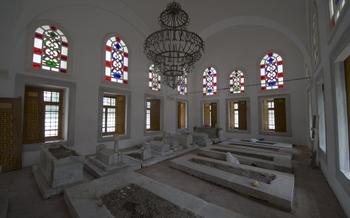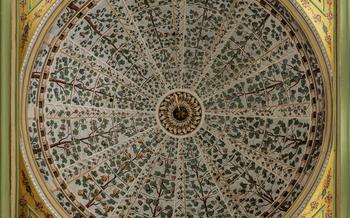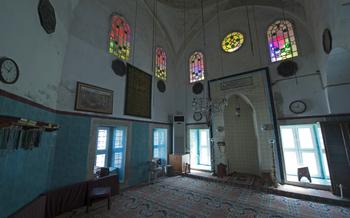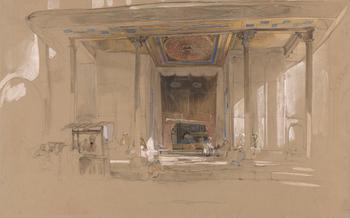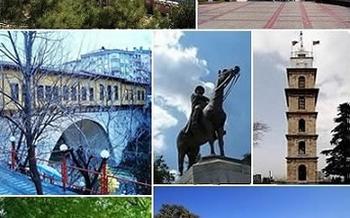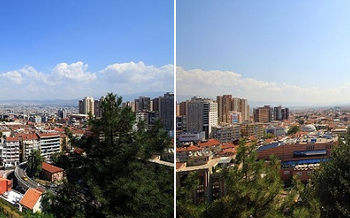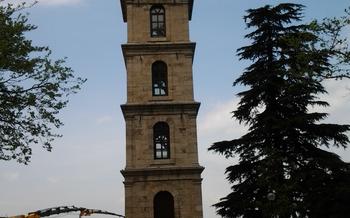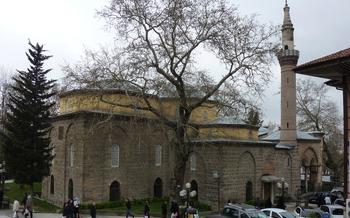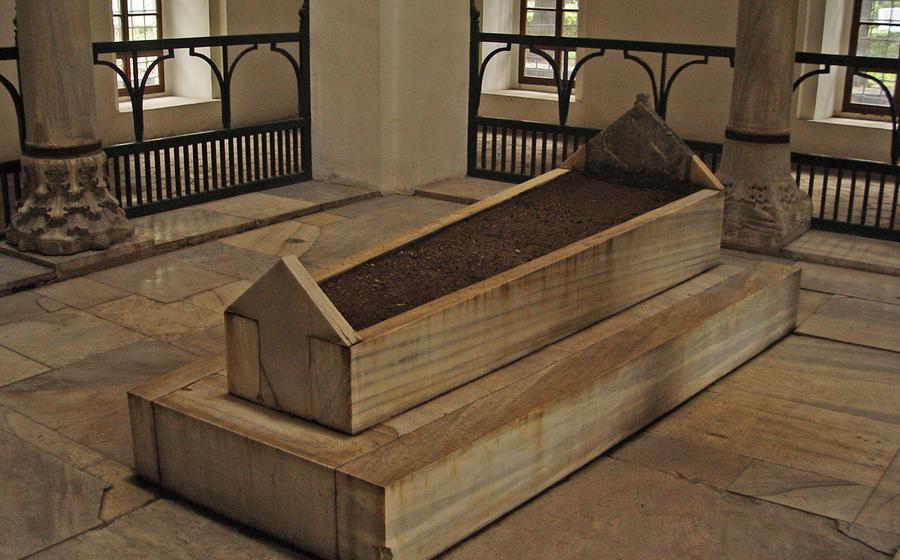
Hüdavendigar Mosque
- Hüdavendigar Mosque: A Majestic Symbol of Bursa's Architectural Heritage
- A Journey Through Time: Exploring the Mosque's History
- Unveiling Architectural Masterpieces: The Mosque's Design Elements
- The Mosque's Enduring Legacy: A Symbol of Bursa's Cultural Identity
- Exploring the Mosque's Surroundings: A Journey into Bursa's Heritage
- Unveiling the Mosque's Secrets: A Glimpse into the Past
- A Photography Haven: Capturing the Mosque's Beauty Through the Lens
- A Place for Reflection and Tranquility: Finding Inner Peace Within the Mosque
- Unveiling the Mosque's Role in Bursa's Urban Fabric: A Historical Perspective
- A Living Legacy: The Mosque's Continuous Role in Bursa's Community
- The Mosque's Place in Islamic Architecture: A Comparative Perspective
- Insider Tip: The Best Time to Visit the Mosque for a Unique Experience
Hüdavendigar Mosque: A Majestic Symbol of Bursa's Architectural Heritage
In the heart of Bursa, a city steeped in history and renowned for its architectural marvels, stands the majestic Hüdavendigar Mosque. Built in the 14th century during the reign of the Ottoman Sultan Murad I, the mosque holds a prominent place in Bursa's rich cultural tapestry. Its awe-inspiring presence reflects the city's pivotal role as the first capital of the Ottoman Empire, embodying the architectural prowess and spiritual fervor that characterized this remarkable era.
The mosque's construction marked a significant milestone in Ottoman architecture, blending Byzantine and Islamic influences to create a unique and harmonious masterpiece. Its intricate carvings, elegant arches, and soaring dome showcase the skill and artistry of its master builders, while its spacious interior exudes an atmosphere of serenity and devotion.
As a religious center, the Hüdavendigar Mosque has played a pivotal role in Bursa's spiritual life for centuries. It has witnessed countless prayers, ceremonies, and festivals, serving as a gathering place for the community to connect, celebrate, and seek solace. Its enduring legacy extends beyond its religious significance, as it has become an iconic landmark deeply embedded in Bursa's cultural identity.
A Journey Through Time: Exploring the Mosque's History
The Hüdavendigar Mosque stands as a testament to the rich history and cultural heritage of Bursa. Its foundation dates back to the early 14th century, when the Ottoman Sultan Hüdavendigar commissioned its construction. The mosque's inception marked a significant chapter in the development of Ottoman architecture, blending Byzantine and Islamic influences to create a unique masterpiece.
Over the centuries, the mosque has undergone several renovations and restorations, each adding to its architectural grandeur. In the 19th century, a major restoration project was undertaken to repair earthquake damage and preserve the mosque's original features. Today, the Hüdavendigar Mosque stands as a symbol of resilience, showcasing the enduring legacy of Ottoman architecture.
During my visit to the mosque, I embarked on a journey of discovery, uncovering the hidden historical details that whispered tales of its past. From the intricate carvings on the exterior facade to the faded inscriptions adorning the interior walls, each element seemed to hold a story waiting to be revealed. It was as if the mosque itself was a living testament to the passage of time, inviting me to explore its rich tapestry of history.
Unveiling Architectural Masterpieces: The Mosque's Design Elements
The Hüdavendigar Mosque stands as a testament to the ingenuity and artistry of its creators. Its exterior facade captivates visitors with its intricate carvings and decorative elements, showcasing the meticulous craftsmanship that went into its construction. The mosque's imposing entrance, flanked by slender minarets, invites worshippers and visitors alike to step into a realm of spiritual and architectural wonder.
The interior of the mosque is equally awe-inspiring, with its soaring central dome and elegant arches creating a sense of grandeur and spaciousness. The exquisite tilework adorning the walls and mihrab adds a vibrant touch, transforming the space into a symphony of colors and patterns. Each tile, meticulously hand-painted, narrates stories from Islamic history and culture, adding depth and meaning to the mosque's design.
Beyond its aesthetic beauty, the mosque's architectural elements hold profound symbolic significance. The central dome, a recurring feature in Islamic architecture, represents the heavens and the connection between the earthly and divine realms. The arches, with their graceful curves, symbolize the unity and strength of the Muslim community. The intricate tilework, often featuring geometric patterns and calligraphy, serves as a reminder of the mosque's religious and cultural heritage.
Exploring the mosque's architectural wonders is a journey of discovery, where each element unveils a deeper layer of meaning and symbolism. The Hüdavendigar Mosque stands as a masterpiece of Islamic architecture, inviting visitors to contemplate the harmony between aesthetics, spirituality, and cultural heritage.
The Mosque's Enduring Legacy: A Symbol of Bursa's Cultural Identity
The Hüdavendigar Mosque stands as a proud testament to Bursa's rich history and cultural heritage, embodying the city's unique identity and traditions. This magnificent structure is not just a place of worship but also a symbol of Bursa's cultural tapestry, reflecting the city's diverse influences and its enduring spirit.
As a visitor, exploring the mosque's intricate details, one cannot help but feel a sense of awe and admiration for the craftsmanship and artistry that went into its creation. The mosque's grand architecture, with its soaring domes, elegant arches, and exquisite tilework, speaks volumes about Bursa's cultural prowess and its position as a significant center of Islamic art and architecture.
Beyond its architectural splendor, the mosque holds a special place in the hearts of Bursa's residents. It is a symbol of their collective identity, a place where they gather for religious observances, community events, and celebrations. The mosque's enduring presence in the city's landscape is a testament to its profound significance to the people of Bursa, who cherish it as a cornerstone of their cultural heritage.
Moreover, the Hüdavendigar Mosque plays a vital role in promoting cultural tourism in Bursa. Its architectural beauty and historical importance attract visitors from around the world, who come to marvel at its splendor and learn about its captivating stories. The mosque's presence on the international stage helps to showcase Bursa's rich cultural heritage and strengthens its position as a must-visit destination for travelers seeking cultural immersion and historical exploration.
For me, personally, standing before the Hüdavendigar Mosque was a profoundly moving experience. As I gazed upon its majestic facade, I felt a deep connection to Bursa's rich history and cultural legacy. The mosque's enduring presence, despite the passage of time, filled me with a sense of awe and admiration for the resilience and artistry of the people who built and preserved this magnificent structure. The Hüdavendigar Mosque is not just a mosque; it is a living symbol of Bursa's cultural identity, a testament to its enduring spirit, and a source of pride for its people.
Exploring the Mosque's Surroundings: A Journey into Bursa's Heritage
Hüdavendigar Mosque stands as a majestic sentinel within the heart of Bursa's historic core. Its strategic location, nestled amidst a tapestry of centuries-old structures, invites visitors to embark on a journey into the city's rich heritage. The mosque's immediate surroundings are a treasure trove of architectural gems, each whispering tales of Bursa's glorious past.
Strolling along the cobblestone streets, visitors are greeted by an array of historical landmarks that complement the mosque's grandeur. The nearby Koza Han, a once-bustling silk market, now transformed into a vibrant cultural center, showcases Bursa's renowned craftsmanship and trading traditions. The Ulu Cami, with its iconic twin minarets, stands as a testament to the city's enduring architectural legacy. The Bursa Castle, perched atop a hill overlooking the cityscape, offers panoramic vistas and a glimpse into the city's fortifications.
Venturing further into the labyrinthine alleys, visitors will discover hidden gems that speak to Bursa's cultural essence. Traditional Turkish bazaars, filled with vibrant textiles, aromatic spices, and delectable sweets, offer a sensory feast. Quaint cafes and shops line the streets, inviting visitors to savor the flavors and hospitality of Bursa. The air is alive with the sounds of craftsmen practicing their trades, the chatter of locals, and the rhythmic call to prayer echoing from the mosque's minarets.
Getting lost in the charming streets surrounding Hüdavendigar Mosque is an adventure in itself. Each turn reveals a new architectural wonder, a hidden courtyard, or a glimpse into the daily lives of Bursa's residents. The harmonious blend of history, culture, and modern life creates a captivating atmosphere that transports visitors back in time while offering a glimpse into the city's vibrant present.
Unveiling the Mosque's Secrets: A Glimpse into the Past
Beyond its grand facade and intricate design, the Hüdavendigar Mosque holds secrets that transport visitors back in time. Hidden within its walls are chambers that once served as libraries or meeting rooms, their shelves adorned with ancient manuscripts and books. Inscriptions etched in stone reveal the names of the mosque's builders and the dates of its construction, providing a tangible connection to the past. Through historical accounts, one can learn about the lives of the mosque's worshippers, from devout scholars to humble peasants, each leaving their mark on this sacred space.
Unveiling these hidden treasures is like embarking on a journey through time, where every discovery offers a glimpse into the rich history and cultural significance of the Hüdavendigar Mosque. Whether it's uncovering a forgotten tale or deciphering an ancient inscription, the mosque's secrets offer a unique opportunity to connect with the past and gain a deeper appreciation for this architectural masterpiece.
Personal Experience:
During my visit to the mosque, I stumbled upon a small, inconspicuous chamber tucked away behind a hidden door. Curiosity piqued, I stepped inside to find shelves lined with dusty books and manuscripts. As I gently lifted one of the volumes, I felt a sense of awe wash over me. Here, in my hands, was a piece of history, a tangible connection to the scholars and students who had once frequented this sacred space. The realization that I was holding a piece of the mosque's rich history filled me with a sense of wonder and reverence.
A Photography Haven: Capturing the Mosque's Beauty Through the Lens
The Hüdavendigar Mosque stands as a magnificent subject for photography enthusiasts, offering a wealth of captivating compositions and intricate details to capture. The mosque's imposing facade, intricate carvings, and decorative elements provide a feast for the eyes, inviting photographers to explore different angles and vantage points to immortalize its grandeur.
The changing light throughout the day further enhances the mosque's visual appeal, casting unique shadows and highlighting different architectural features. As the sun rises, the mosque's exterior glows with a warm golden hue, while the sunset paints the sky with vibrant colors that reflect off the mosque's domes and minarets.
Capturing the mosque's beauty through photography requires patience and an eye for detail. Photographers can experiment with different focal lengths and perspectives to emphasize specific elements, such as the intricate tilework, the graceful arches, or the towering minarets.
Tripod use is recommended to ensure sharp images, especially when shooting in low-light conditions. Additionally, photographers should consider using a wide-angle lens to capture the mosque's full grandeur or a telephoto lens to zoom in on specific details.
The reward for photographers who take the time to explore and capture the Hüdavendigar Mosque is a stunning collection of images that showcase the mosque's architectural wonders and evoke the spiritual essence of this historic landmark.
A Place for Reflection and Tranquility: Finding Inner Peace Within the Mosque
Hüdavendigar Mosque stands as a sanctuary for those seeking solace and inner peace amidst the bustling city. Its serene atmosphere, adorned with intricate tilework and soft lighting, invites visitors to pause and reflect. The rhythmic echoes of prayers reverberate through the vast hall, creating a harmonious ambiance that fosters a sense of tranquility. Whether you are a devout worshipper or a traveler seeking a moment of respite, the mosque provides a haven where you can connect with your spirituality and find solace within its sacred walls.
In the quiet corners of the mosque, you can sit in contemplation, allowing your thoughts to settle and your worries to dissolve. The soft glow of the stained-glass windows casts intricate patterns on the floor, creating a mesmerizing effect that draws your attention inward. The rhythmic chanting of the imam during prayers fills the air with a spiritual melody that soothes the soul.
As you immerse yourself in the serene ambiance of the mosque, you may find yourself overcome with a sense of awe and humility. The intricate details of the architecture, the devotion of the worshippers, and the palpable sense of history all contribute to an experience that transcends mere sightseeing. Whether you are a believer or not, the Hüdavendigar Mosque offers a space for reflection and renewal, where you can find inner peace and connect with your spiritual side.
Unveiling the Mosque's Role in Bursa's Urban Fabric: A Historical Perspective
The Hüdavendigar Mosque stands as a testament to Bursa's rich history and cultural heritage, deeply embedded in the city's urban fabric. From its inception, the mosque has played a pivotal role in shaping Bursa's development, serving as a spiritual, social, and architectural landmark.
The mosque's strategic location within the old city, adjacent to the bustling bazaar, reflects its significance as a center of religious and commercial activity. Its imposing presence has influenced the surrounding urban landscape, with narrow streets and traditional Ottoman-style houses converging towards the mosque, creating a harmonious architectural ensemble.
Throughout the centuries, the mosque has witnessed Bursa's transformation, from a small Byzantine town to the flourishing capital of the Ottoman Empire. It has served as a backdrop for significant historical events, witnessed the rise and fall of dynasties, and endured various challenges, including earthquakes and fires.
The mosque's resilience and enduring legacy speak to its profound impact on Bursa's urban fabric. It remains a symbol of the city's rich past, a reminder of its architectural heritage, and a source of pride for its residents.
A Living Legacy: The Mosque's Continuous Role in Bursa's Community
The Hüdavendigar Mosque stands not only as a testament to Bursa's architectural heritage but also as a vibrant and active center within the city's community. Far from being a relic of the past, the mosque continues to play a crucial role in the social and cultural fabric of Bursa.
The mosque serves as a venue for various events, workshops, and educational programs that bring together people from all walks of life. These events range from religious teachings and Quranic studies to art exhibitions and cultural performances. The mosque's spacious courtyard and inviting atmosphere make it an ideal setting for these gatherings, fostering a sense of community and belonging.
Beyond religious and educational activities, the Hüdavendigar Mosque is also actively involved in providing social services to those in need. The mosque's charitable foundation extends support to the underprivileged, offering financial assistance, food distributions, and healthcare services. The mosque's commitment to social welfare reflects its deep-rooted belief in compassion, solidarity, and the betterment of the community.
Moreover, the Hüdavendigar Mosque plays a vital role in promoting interfaith dialogue and understanding. The mosque's leadership actively engages in initiatives that bring together representatives from different faiths, fostering respectful conversations and promoting mutual understanding. These interfaith dialogues contribute to breaking down barriers, building bridges between communities, and fostering a spirit of harmony and coexistence.
Witnessing the mosque's active involvement in community engagement is a truly inspiring experience. The Hüdavendigar Mosque stands as a beacon of hope, unity, and service, demonstrating the power of faith to bring people together and make a positive impact on society.
The Mosque's Place in Islamic Architecture: A Comparative Perspective
The Hüdavendigar Mosque stands as a testament to the rich tapestry of Islamic architecture, embodying a harmonious blend of various styles and influences. Its grand dome, reminiscent of the Hagia Sophia in Istanbul, showcases the mosque's Byzantine heritage. The intricate tilework adorning its interior walls draws inspiration from the vibrant colors and patterns of Islamic art. The mosque's minarets, reaching towards the sky, echo the architectural traditions of Seljuk and Ottoman mosques.
Comparing the Hüdavendigar Mosque with other significant Islamic mosques reveals both similarities and differences. The mosque's vast central dome, for instance, shares a structural affinity with the iconic Dome of the Rock in Jerusalem, a masterpiece of early Islamic architecture. However, the Hüdavendigar Mosque's exterior ornamentation, characterized by intricate carvings and glazed tiles, distinguishes it from the austere simplicity of the Dome of the Rock.
Exploring the regional influences on the mosque's design, one can trace elements of Persian architecture in its graceful arches and iwans. The use of colorful tiles and ceramics reflects the artistic traditions of the Islamic world, particularly the vibrant Iznik tiles that adorn many Ottoman structures. The mosque's overall design exemplifies the cultural exchange and artistic synthesis that characterized the Ottoman Empire, where diverse influences converged to create unique architectural expressions.
Understanding the mosque's place within the broader development of Islamic architecture requires recognizing its historical context. The Hüdavendigar Mosque was built during the early Ottoman period, a time of significant architectural innovation and experimentation. The mosque's design reflects the transition from the Seljuk to the Ottoman architectural style, embodying the evolving artistic sensibilities of the empire. Its grandeur and sophistication paved the way for the development of subsequent Ottoman mosques, such as the Süleymaniye Mosque in Istanbul, which further refined and elaborated on the architectural principles established by the Hüdavendigar Mosque.
When contemplating the Hüdavendigar Mosque's place in Islamic architecture, one is struck by its unique blend of styles and influences. The mosque stands as a testament to the cultural diversity and artistic achievements of the Ottoman Empire, showcasing the empire's ability to synthesize diverse traditions into a cohesive and visually stunning architectural masterpiece.
Insider Tip: The Best Time to Visit the Mosque for a Unique Experience
To truly experience the magic of the Hüdavendigar Mosque, timing is everything. Avoid the peak tourist season, which typically falls between June and August, to escape the crowds and fully immerse yourself in the mosque's serene atmosphere. Instead, opt for the shoulder seasons of spring or autumn when the weather is still pleasant, and the city is less congested.
For an unforgettable experience, plan your visit to coincide with one of Bursa's many special events or festivals. The annual Bursa Silk Festival, held in June, is a vibrant celebration of the city's rich textile heritage. During the festival, the mosque's courtyard transforms into a lively marketplace filled with colorful stalls selling exquisite silk scarves, carpets, and other traditional handicrafts.
If you seek a more spiritual encounter, time your visit during the holy month of Ramadan, when the mosque comes alive with the sounds of fervent prayers and recitations. This is a time of deep reflection and devotion, and witnessing the mosque's heightened spiritual energy is an experience that will stay with you long after your visit.

